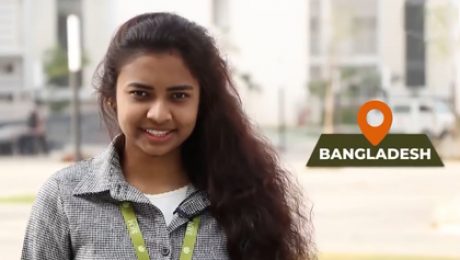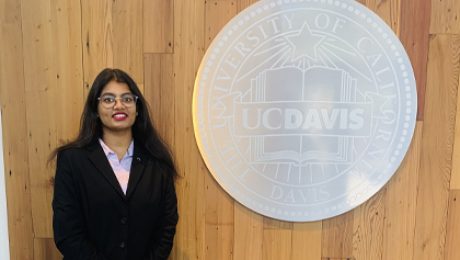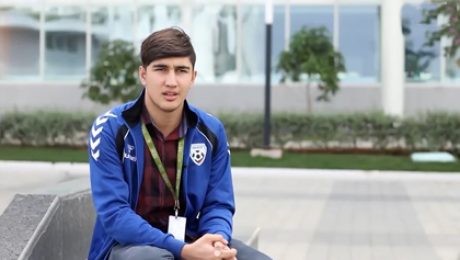SRMAP Faculty Enlisted in Stanford Global List of Top 2% Scientists
Daily Pioneer – Oct 23
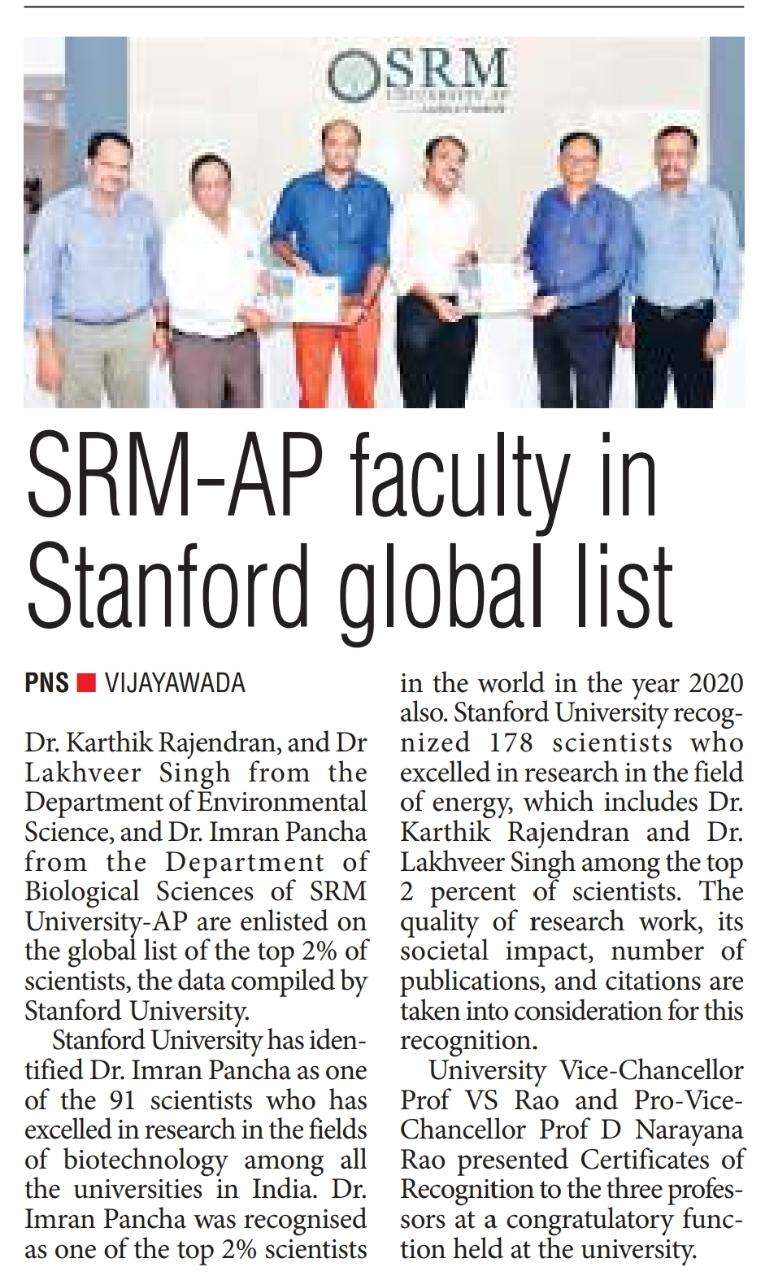
Trinity Mirror – Oct 23

The Hawk – Oct 23
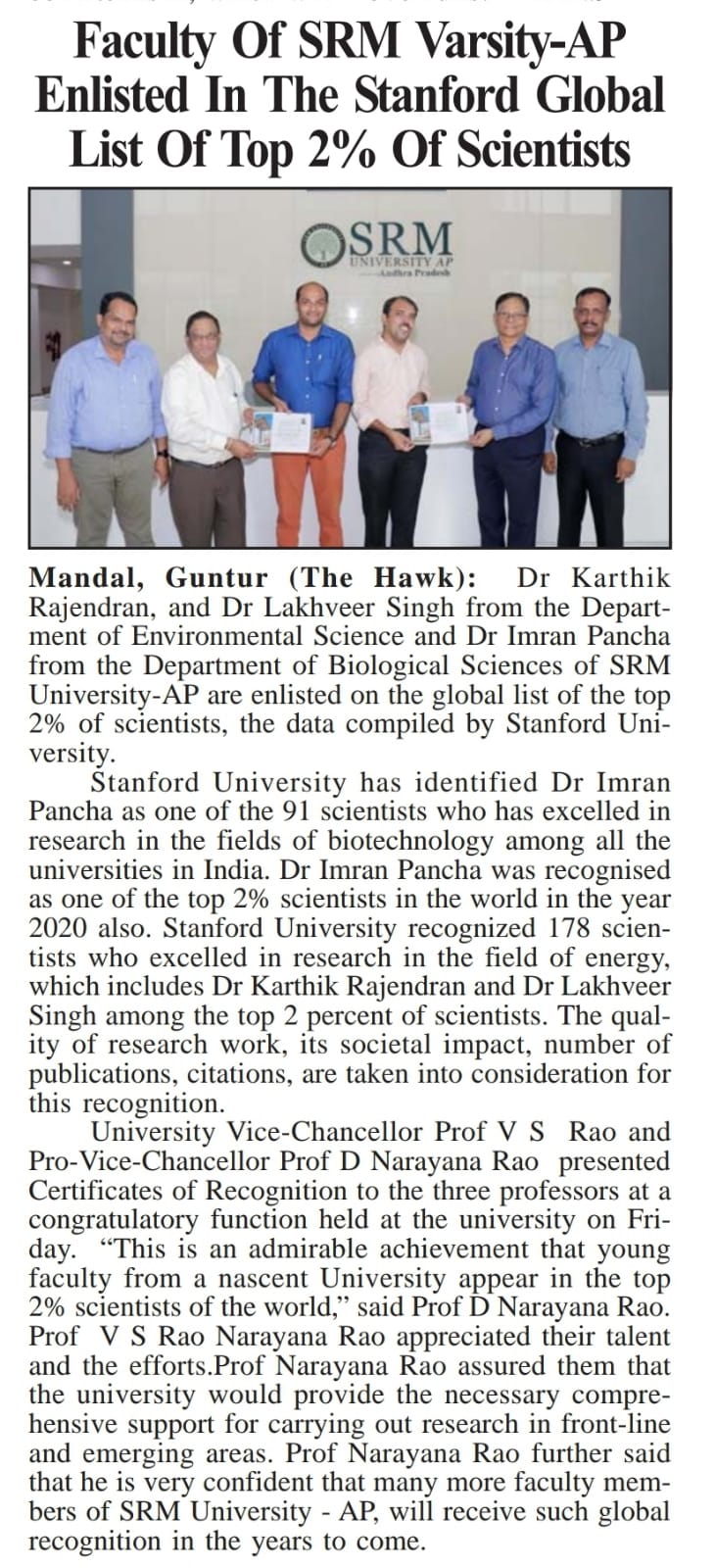
Sakshi – Oct 23
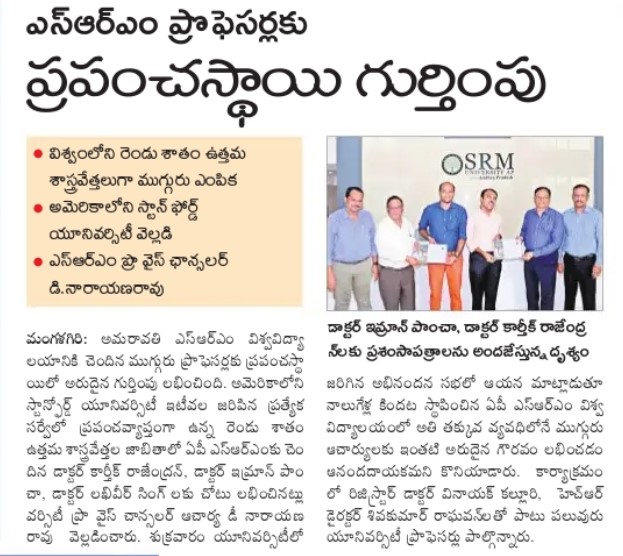
Andhra Prabha – Oct 23
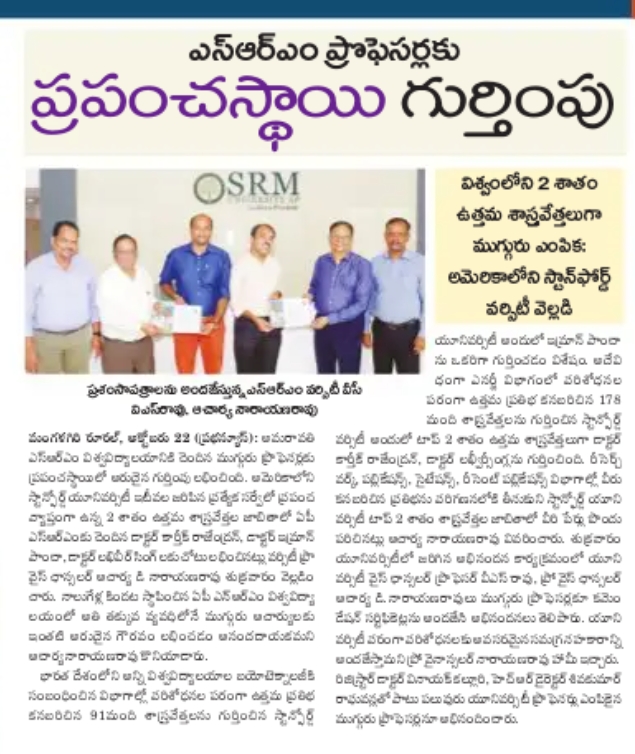
PrajaSakthi – Oct 23
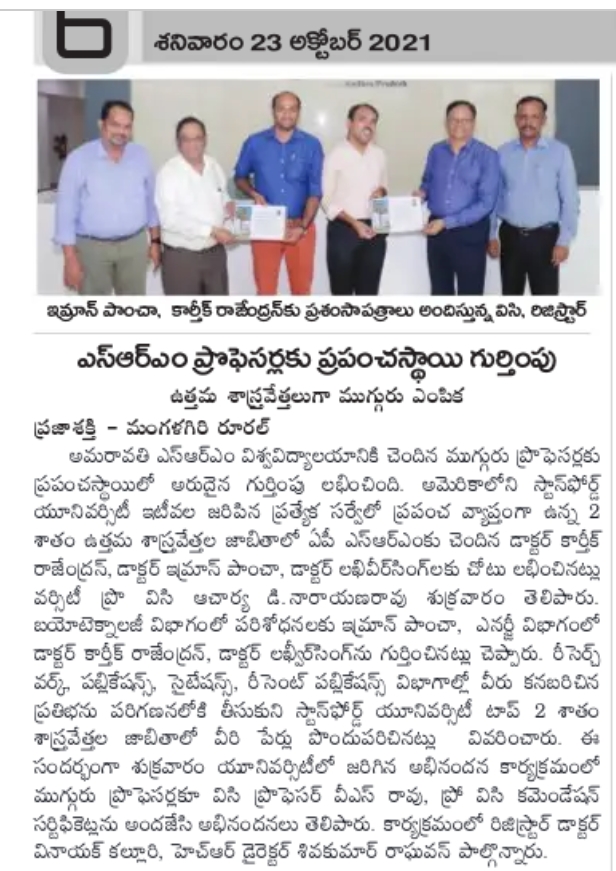
Surya – Oct 23
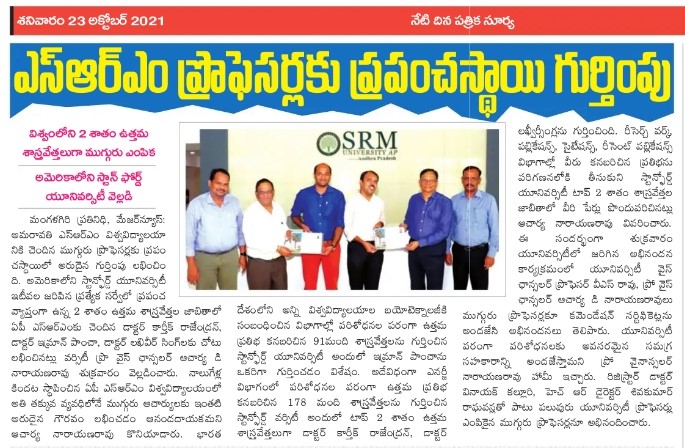
Visalaandhra – Oct 23
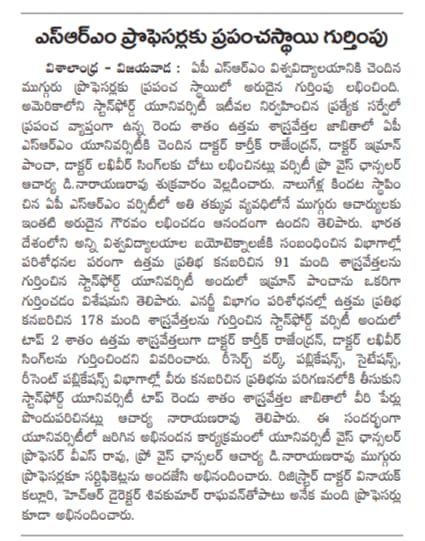
- Published in Newsroom
BSc Physics student contributes as the First Author for a research paper
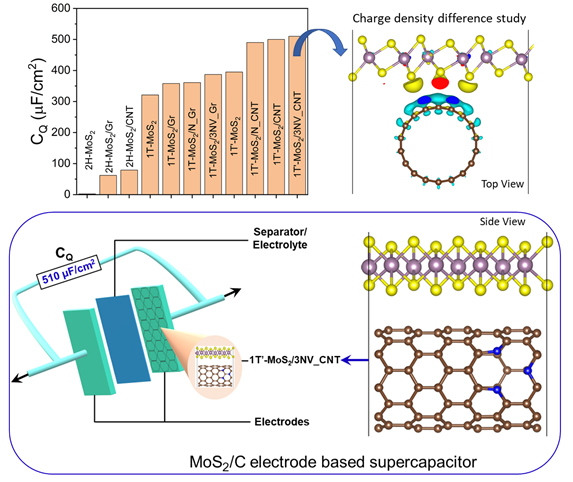 A research paper titled “First Principle Identification of 2D-MoS2 based Composite Electrodes for Efficient Supercapacitor Application” is published by Samadhan Kapse, PhD student, as First Author and Bennet Benny, BSc Physics Student, (Same Contributed First Author) in the Journal of energy storage, Elsevier having an Impact Factor of 6.583. The paper publication has been guided and supervised by Dr Pranab Mandal (Co-Author) and Prof Ranjit Thapa (Corresponding Author) from the Department of Physics, SRM University-AP.
A research paper titled “First Principle Identification of 2D-MoS2 based Composite Electrodes for Efficient Supercapacitor Application” is published by Samadhan Kapse, PhD student, as First Author and Bennet Benny, BSc Physics Student, (Same Contributed First Author) in the Journal of energy storage, Elsevier having an Impact Factor of 6.583. The paper publication has been guided and supervised by Dr Pranab Mandal (Co-Author) and Prof Ranjit Thapa (Corresponding Author) from the Department of Physics, SRM University-AP.
1T Molybdenum disulfide (1T-MoS2) has been widely studied experimentally as an electrode for supercapacitors due to its excellent electrical and electrochemical properties. Whereas the capacitance value in MoS2 is limited due to the lower density of electrons near the Fermi level, and unable to fulfil the demand of industry i.e. quantum capacitance preferably higher than 300 μF/cm2. Here, we investigated the performance of 2H, 1T, and 1T’ phases of MoS2 in its pristine form and heterostructures with carbon-based structures as an electrode in the supercapacitors using density functional theory. Specifically, we reported that the underneath carbon nanotube (CNT) is responsible for the structural phase transition from 1T to 1T’ phase of MoS2 monolayer in 1T’-MoS2/CNT heterostructure. This is the main reason for a large density of states near the Fermi level of 1T’-MoS2/CNT that exhibits high quantum capacitance (CQ) of 500 μF/cm2 at a potential of 0.6 V. Also, we observed that the nitrogen doping and defects in the underneath carbon surface amplify the CQ of heterostructure for a wider range of electrode potential. Therefore, the 1T’-MoS2 /N doped CNT can be explored as an electrode for next-generation supercapacitors.
Today’s increasing demand for energy storage technologies is highly dependent on batteries, fuel cells, supercapacitors, etc. The supercapacitors are greatly efficient due to advantages such as high power density, wide operating temperature range, large charge-discharge cycles. The recent focus of researchers is to find promising electrode materials for supercapacitor application. Among all reported works, the MoS2 nanosheet is found to be a prime candidate for supercapacitors with a high power density as well as energy density. Therefore, it is important to understand the origin of capacitance in MoS2 and their composites to design promising electrodes for supercapacitors. Also, the identification of ideal MoS2 based composites for efficient supercapacitor application is a grand challenge using only experimental approaches.
Using density functional theory, we can identify the promising electrode materials for supercapacitor application based on various graphene, 2D metal chalcogenides and their heterostructures. The quantum capacitance (CQ) is the cost-effective method to estimate the performance of any low density of states materials such as graphene, MoS2, etc towards supercapacitors.
- Published in Departmental News, News, Physics News, Research News
From Bangladesh to India
SRM-AP is like a home away from home to me. There is never a dull moment on this campus. Students are always engaged in studies or extracurricular activities. I am happy that I travelled to a new country, learned a new culture and made a lot of new friends here. The activities of clubs and societies made my campus life more vibrant.
-Mahjabeen Tamanna
Mechanical Engineering
- Published in IR-Testimonials
Semester Abroad Programme at UC Davis
Semester Abroad Programme at UC Davis changed my outlook on life. I got the opportunity to cooperate with industrial designers. For practical hands-on experiences, I worked for the UC Davis school of nursing. Besides, UC Davis promotes a variety of student clubs and technical programmes that bring students from all over the world together. The concrete understanding of the subject aided me greatly in learning about real-world problems, and accomplishing this dream of studying a semester abroad.
– Barukula Snehitha Naga Sai
Computer Science Engineering
- Published in IR-Testimonials
Flying high beyond borders
It has been a really good experience being at SRM University-AP. This is a place where dreams transform into reality. I really appreciate the curriculum structure at SRM University-AP that offers us practical knowledge rather than forcing us to memorise theories.
-Sohail Basha Shaik
Computer Science Engineering
- Published in International Relations, IR-Testimonials
STIP- 2020: “Impartial inclusion will make India global scientific superpower”
“India is moving towards ‘technological self-reliance’ and will emerge as one of the ‘Top 3 scientific superpowers’ through Science, Technology and Innovation Policy (STIP) 2020: A Transformative Science and Technology Agenda,” said Dr Sandeep Verma, Secretary of Science and Engineering Research Board (SERB), in the thirteenth edition of University Distinguished Lecture Series conducted by SRM University-AP, Andhra Pradesh on October 30, 2021.
The objectives of the Distinguished Lecture were enumerated by the Pro-Vice-Chancellor, Prof D Narayana Rao. He further said that the STIP: 2020 will greatly enhance the scientific contributions of Universities, Institutions and National Laboratories. He said that Universities and Institutions are hubs for innovations.
Dr Verma, a recipient of one of the highest Indian awards in the field of Science, the Shanti Swarup Bhatnagar Prize, is known for his contributions towards experimental medicine by working in the areas of bio-chemical interface. Prof Verma felt that the vision behind STIP: 2020 can only be executed through innovative, collaborative, and open science research that is best implemented in Universities and Educational Institutions like SRM University-AP.
Dr Verma elucidated that the primary idea behind STIP: 2020 is Inclusivity. STIP: 2020 will require an uninhibited and indiscriminate free flow of scientific and innovative ideas between all the people with a scientific interest from the Indian diaspora and from rural India, from all genders, from all age groups ignoring any disability physical or otherwise. “We can’t afford to leave anyone behind”, Dr Verma said referring to India’s quest to become a scientific and technological superpower. Prof Sandeep Verma said that the gross spending of the country on R & D increased 3 times during the last 8 years.
Appreciating the efforts made by SRM University-AP, Dr Verma emphasised the need to have the researchers coming out in the open, solving real-life problems and making every individual Indian life better. “It is our Scientific Social Responsibility to conduct such open forums for scientific communication and understanding,” he said, “As India prepares to grow towards technological self-reliance and indigenisation with the support of various schemes under Atmanirbhar Bharat and develop an ecosystem worthy of global benchmark, STIP: 2020 comes as a landmark innovation policy at this crucial juncture.”
Dr Verma ended his talk with the hopeful note that other Universities would follow the example of SRM University-AP and make such conscientious efforts towards innovation to make lives better. The lecture was attended by Dr S Chandrasekhar, Director, CSIR-IICT and over 2300 members from several premier institutions like IITs, NITs, IISERs, Universities and Institutions, CSIR, DST, DBT, DRDO, DAE, ISRO, NARL, MoES and several others from different parts of the country.
Prof V S Rao, Vice-Chancellor and Prof D Narayana Rao, Pro-Vice-Chancellor felicitated Prof Sandeep Verma and presented him with a memento.
- Published in News, Research News


